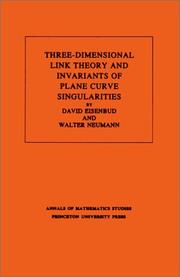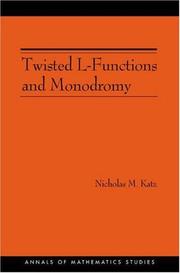| Listing 1 - 5 of 5 |
Sort by
|

ISBN: 0691083819 0691083800 1400881927 9780691083810 9780691083803 Year: 1985 Volume: 110 Publisher: Princeton Princeton University Press
Abstract | Keywords | Export | Availability | Bookmark
 Loading...
Loading...Choose an application
- Reference Manager
- EndNote
- RefWorks (Direct export to RefWorks)
This book gives a new foundation for the theory of links in 3-space modeled on the modern developmentby Jaco, Shalen, Johannson, Thurston et al. of the theory of 3-manifolds. The basic construction is a method of obtaining any link by "splicing" links of the simplest kinds, namely those whose exteriors are Seifert fibered or hyperbolic. This approach to link theory is particularly attractive since most invariants of links are additive under splicing.Specially distinguished from this viewpoint is the class of links, none of whose splice components is hyperbolic. It includes all links constructed by cabling and connected sums, in particular all links of singularities of complex plane curves. One of the main contributions of this monograph is the calculation of invariants of these classes of links, such as the Alexander polynomials, monodromy, and Seifert forms.
Algebraic geometry --- Differential geometry. Global analysis --- Link theory. --- Curves, Plane. --- SINGULARITIES (Mathematics) --- Curves, Plane --- Invariants --- Link theory --- Singularities (Mathematics) --- Geometry, Algebraic --- Low-dimensional topology --- Piecewise linear topology --- Higher plane curves --- Plane curves --- Invariants. --- 3-sphere. --- Alexander Grothendieck. --- Alexander polynomial. --- Algebraic curve. --- Algebraic equation. --- Algebraic geometry. --- Algebraic surface. --- Algorithm. --- Ambient space. --- Analytic function. --- Approximation. --- Big O notation. --- Call graph. --- Cartesian coordinate system. --- Characteristic polynomial. --- Closed-form expression. --- Cohomology. --- Computation. --- Conjecture. --- Connected sum. --- Contradiction. --- Coprime integers. --- Corollary. --- Curve. --- Cyclic group. --- Determinant. --- Diagram (category theory). --- Diffeomorphism. --- Dimension. --- Disjoint union. --- Eigenvalues and eigenvectors. --- Equation. --- Equivalence class. --- Euler number. --- Existential quantification. --- Exterior (topology). --- Fiber bundle. --- Fibration. --- Foliation. --- Fundamental group. --- Geometry. --- Graph (discrete mathematics). --- Ground field. --- Homeomorphism. --- Homology sphere. --- Identity matrix. --- Integer matrix. --- Intersection form (4-manifold). --- Isolated point. --- Isolated singularity. --- Jordan normal form. --- Knot theory. --- Mathematical induction. --- Monodromy matrix. --- Monodromy. --- N-sphere. --- Natural transformation. --- Newton polygon. --- Newton's method. --- Normal (geometry). --- Notation. --- Pairwise. --- Parametrization. --- Plane curve. --- Polynomial. --- Power series. --- Projective plane. --- Puiseux series. --- Quantity. --- Rational function. --- Resolution of singularities. --- Riemann sphere. --- Riemann surface. --- Root of unity. --- Scientific notation. --- Seifert surface. --- Set (mathematics). --- Sign (mathematics). --- Solid torus. --- Special case. --- Stereographic projection. --- Submanifold. --- Summation. --- Theorem. --- Three-dimensional space (mathematics). --- Topology. --- Torus knot. --- Torus. --- Tubular neighborhood. --- Unit circle. --- Unit vector. --- Unknot. --- Variable (mathematics).

ISBN: 1282820893 9786612820892 1400824885 069109151X 0691091501 9781400824885 9780691091501 9780691091518 9781282820890 6612820896 Year: 2009 Volume: 150 Publisher: Princeton, NJ
Abstract | Keywords | Export | Availability | Bookmark
 Loading...
Loading...Choose an application
- Reference Manager
- EndNote
- RefWorks (Direct export to RefWorks)
For hundreds of years, the study of elliptic curves has played a central role in mathematics. The past century in particular has seen huge progress in this study, from Mordell's theorem in 1922 to the work of Wiles and Taylor-Wiles in 1994. Nonetheless, there remain many fundamental questions where we do not even know what sort of answers to expect. This book explores two of them: What is the average rank of elliptic curves, and how does the rank vary in various kinds of families of elliptic curves? Nicholas Katz answers these questions for families of ''big'' twists of elliptic curves in the function field case (with a growing constant field). The monodromy-theoretic methods he develops turn out to apply, still in the function field case, equally well to families of big twists of objects of all sorts, not just to elliptic curves. The leisurely, lucid introduction gives the reader a clear picture of what is known and what is unknown at present, and situates the problems solved in this book within the broader context of the overall study of elliptic curves. The book's technical core makes use of, and explains, various advanced topics ranging from recent results in finite group theory to the machinery of l-adic cohomology and monodromy. Twisted L-Functions and Monodromy is essential reading for anyone interested in number theory and algebraic geometry.
L-functions. --- Monodromy groups. --- Functions, L --- -L-functions. --- Group theory --- -Number theory --- L-functions --- Monodromy groups --- Abelian variety. --- Absolute continuity. --- Addition. --- Affine space. --- Algebraically closed field. --- Ambient space. --- Average. --- Betti number. --- Birch and Swinnerton-Dyer conjecture. --- Blowing up. --- Codimension. --- Coefficient. --- Computation. --- Conjecture. --- Conjugacy class. --- Convolution. --- Critical value. --- Differential geometry of surfaces. --- Dimension (vector space). --- Dimension. --- Direct sum. --- Divisor (algebraic geometry). --- Divisor. --- Eigenvalues and eigenvectors. --- Elliptic curve. --- Equation. --- Equidistribution theorem. --- Existential quantification. --- Factorization. --- Finite field. --- Finite group. --- Finite set. --- Flat map. --- Fourier transform. --- Function field. --- Functional equation. --- Goursat's lemma. --- Ground field. --- Group representation. --- Hyperplane. --- Hypersurface. --- Integer matrix. --- Integer. --- Irreducible component. --- Irreducible polynomial. --- Irreducible representation. --- J-invariant. --- K3 surface. --- L-function. --- Lebesgue measure. --- Lefschetz pencil. --- Level of measurement. --- Lie algebra. --- Limit superior and limit inferior. --- Minimal polynomial (field theory). --- Modular form. --- Monodromy. --- Morphism. --- Numerical analysis. --- Orthogonal group. --- Percentage. --- Polynomial. --- Prime number. --- Probability measure. --- Quadratic function. --- Quantity. --- Quotient space (topology). --- Representation theory. --- Residue field. --- Riemann hypothesis. --- Root of unity. --- Scalar (physics). --- Set (mathematics). --- Sheaf (mathematics). --- Subgroup. --- Summation. --- Symmetric group. --- System of imprimitivity. --- Theorem. --- Trivial representation. --- Zariski topology.

ISBN: 0691081492 1400881420 9780691081496 Year: 1975 Volume: 82 Publisher: Princeton (N.J.): Princeton university press,
Abstract | Keywords | Export | Availability | Bookmark
 Loading...
Loading...Choose an application
- Reference Manager
- EndNote
- RefWorks (Direct export to RefWorks)
The central theme of this study is Artin's braid group and the many ways that the notion of a braid has proved to be important in low-dimensional topology.In Chapter 1 the author is concerned with the concept of a braid as a group of motions of points in a manifold. She studies structural and algebraic properties of the braid groups of two manifolds, and derives systems of defining relations for the braid groups of the plane and sphere. In Chapter 2 she focuses on the connections between the classical braid group and the classical knot problem. After reviewing basic results she proceeds to an exploration of some possible implications of the Garside and Markov theorems.Chapter 3 offers discussion of matrix representations of the free group and of subgroups of the automorphism group of the free group. These ideas come to a focus in the difficult open question of whether Burau's matrix representation of the braid group is faithful. Chapter 4 is a broad view of recent results on the connections between braid groups and mapping class groups of surfaces. Chapter 5 contains a brief discussion of the theory of "plats." Research problems are included in an appendix.
Braid theory --- Braids, Theory of --- Theory of braids --- Braid theory. --- Algebraic topology --- Knot theory --- Representations of groups --- 512.54 --- Group representation (Mathematics) --- Groups, Representation theory of --- Group theory --- Knots (Topology) --- Low-dimensional topology --- 512.54 Groups. Group theory --- Groups. Group theory --- Knot theory. --- Representations of groups. --- Addition. --- Alexander polynomial. --- Algebraic structure. --- Automorphism. --- Ball (mathematics). --- Bijection. --- Braid group. --- Branched covering. --- Burau representation. --- Calculation. --- Cartesian coordinate system. --- Characterization (mathematics). --- Coefficient. --- Combinatorial group theory. --- Commutative property. --- Commutator subgroup. --- Configuration space. --- Conjugacy class. --- Corollary. --- Covering space. --- Dehn twist. --- Determinant. --- Diagram (category theory). --- Dimension. --- Disjoint union. --- Double coset. --- Eigenvalues and eigenvectors. --- Enumeration. --- Equation. --- Equivalence class. --- Exact sequence. --- Existential quantification. --- Faithful representation. --- Finite set. --- Free abelian group. --- Free group. --- Fundamental group. --- Geometry. --- Group (mathematics). --- Group ring. --- Groupoid. --- Handlebody. --- Heegaard splitting. --- Homeomorphism. --- Homomorphism. --- Homotopy group. --- Homotopy. --- Identity element. --- Identity matrix. --- Inclusion map. --- Initial point. --- Integer matrix. --- Integer. --- Knot polynomial. --- Lens space. --- Line segment. --- Line–line intersection. --- Link group. --- Low-dimensional topology. --- Mapping class group. --- Mathematical induction. --- Mathematics. --- Matrix group. --- Matrix representation. --- Monograph. --- Morphism. --- Natural transformation. --- Normal matrix. --- Notation. --- Orientability. --- Parity (mathematics). --- Permutation. --- Piecewise linear. --- Pointwise. --- Polynomial. --- Prime knot. --- Projection (mathematics). --- Proportionality (mathematics). --- Quotient group. --- Requirement. --- Rewriting. --- Riemann surface. --- Semigroup. --- Sequence. --- Special case. --- Subgroup. --- Submanifold. --- Subset. --- Symmetric group. --- Theorem. --- Theory. --- Topology. --- Trefoil knot. --- Two-dimensional space. --- Unimodular matrix. --- Unit vector. --- Variable (mathematics). --- Word problem (mathematics). --- Topologie algébrique
Book

ISBN: 140088151X Year: 2016 Publisher: Princeton, NJ : Princeton University Press,
Abstract | Keywords | Export | Availability | Bookmark
 Loading...
Loading...Choose an application
- Reference Manager
- EndNote
- RefWorks (Direct export to RefWorks)
There is a sympathy of ideas among the fields of knot theory, infinite discrete group theory, and the topology of 3-manifolds. This book contains fifteen papers in which new results are proved in all three of these fields. These papers are dedicated to the memory of Ralph H. Fox, one of the world's leading topologists, by colleagues, former students, and friends.In knot theory, papers have been contributed by Goldsmith, Levine, Lomonaco, Perko, Trotter, and Whitten. Of these several are devoted to the study of branched covering spaces over knots and links, while others utilize the braid groups of Artin.Cossey and Smythe, Stallings, and Strasser address themselves to group theory. In his contribution Stallings describes the calculation of the groups In/In+1 where I is the augmentation ideal in a group ring RG. As a consequence, one has for each k an example of a k-generator l-relator group with no free homomorphs. In the third part, papers by Birman, Cappell, Milnor, Montesinos, Papakyriakopoulos, and Shalen comprise the treatment of 3-manifolds. Milnor gives, besides important new results, an exposition of certain aspects of our current knowledge regarding the 3- dimensional Brieskorn manifolds.
Knot theory. --- Group theory. --- Three-manifolds (Topology) --- 3-manifold. --- 3-sphere. --- Additive group. --- Alexander duality. --- Algebraic equation. --- Algebraic surface. --- Algebraic variety. --- Automorphic form. --- Automorphism. --- Big O notation. --- Bilinear form. --- Borromean rings. --- Boundary (topology). --- Braid group. --- Cartesian product. --- Central series. --- Chain rule. --- Characteristic polynomial. --- Coefficient. --- Cohomological dimension. --- Commutative ring. --- Commutator subgroup. --- Complex Lie group. --- Complex coordinate space. --- Complex manifold. --- Complex number. --- Conjugacy class. --- Connected sum. --- Coprime integers. --- Coset. --- Counterexample. --- Cyclic group. --- Dedekind domain. --- Diagram (category theory). --- Diffeomorphism. --- Disjoint union. --- Divisibility rule. --- Double coset. --- Equation. --- Equivalence class. --- Euler characteristic. --- Fiber bundle. --- Finite group. --- Fundamental group. --- Generating set of a group. --- Graded ring. --- Graph product. --- Group ring. --- Groupoid. --- Heegaard splitting. --- Holomorphic function. --- Homeomorphism. --- Homological algebra. --- Homology (mathematics). --- Homology sphere. --- Homomorphism. --- Homotopy group. --- Homotopy sphere. --- Homotopy. --- Hurewicz theorem. --- Infimum and supremum. --- Integer matrix. --- Integer. --- Intersection number (graph theory). --- Intersection theory. --- Knot group. --- Knot polynomial. --- Loop space. --- Main diagonal. --- Manifold. --- Mapping cylinder. --- Mathematical induction. --- Meromorphic function. --- Monodromy. --- Monomorphism. --- Multiplicative group. --- Permutation. --- Poincaré conjecture. --- Principal ideal domain. --- Proportionality (mathematics). --- Quotient space (topology). --- Riemann sphere. --- Riemann surface. --- Seifert fiber space. --- Simplicial category. --- Special case. --- Spectral sequence. --- Subgroup. --- Submanifold. --- Surjective function. --- Symmetric group. --- Symplectic matrix. --- Theorem. --- Three-dimensional space (mathematics). --- Topology. --- Torus knot. --- Triangle group. --- Variable (mathematics). --- Weak equivalence (homotopy theory).
Book
ISBN: 0691186901 Year: 2018 Publisher: Princeton, NJ : Princeton University Press,
Abstract | Keywords | Export | Availability | Bookmark
 Loading...
Loading...Choose an application
- Reference Manager
- EndNote
- RefWorks (Direct export to RefWorks)
An elliptic curve is a particular kind of cubic equation in two variables whose projective solutions form a group. Modular forms are analytic functions in the upper half plane with certain transformation laws and growth properties. The two subjects--elliptic curves and modular forms--come together in Eichler-Shimura theory, which constructs elliptic curves out of modular forms of a special kind. The converse, that all rational elliptic curves arise this way, is called the Taniyama-Weil Conjecture and is known to imply Fermat's Last Theorem. Elliptic curves and the modeular forms in the Eichler- Shimura theory both have associated L functions, and it is a consequence of the theory that the two kinds of L functions match. The theory covered by Anthony Knapp in this book is, therefore, a window into a broad expanse of mathematics--including class field theory, arithmetic algebraic geometry, and group representations--in which the concidence of L functions relates analysis and algebra in the most fundamental ways. Developing, with many examples, the elementary theory of elliptic curves, the book goes on to the subject of modular forms and the first connections with elliptic curves. The last two chapters concern Eichler-Shimura theory, which establishes a much deeper relationship between the two subjects. No other book in print treats the basic theory of elliptic curves with only undergraduate mathematics, and no other explains Eichler-Shimura theory in such an accessible manner.
Curves, Elliptic. --- Affine plane (incidence geometry). --- Affine space. --- Affine variety. --- Algebra homomorphism. --- Algebraic extension. --- Algebraic geometry. --- Algebraic integer. --- Algebraic number theory. --- Algebraic number. --- Analytic continuation. --- Analytic function. --- Associative algebra. --- Automorphism. --- Big O notation. --- Binary quadratic form. --- Birch and Swinnerton-Dyer conjecture. --- Bounded set (topological vector space). --- Change of variables. --- Characteristic polynomial. --- Coefficient. --- Compactification (mathematics). --- Complex conjugate. --- Complex manifold. --- Complex number. --- Conjecture. --- Coprime integers. --- Cusp form. --- Cyclic group. --- Degeneracy (mathematics). --- Dimension (vector space). --- Dirichlet character. --- Dirichlet series. --- Division algebra. --- Divisor. --- Eigenform. --- Eigenvalues and eigenvectors. --- Elementary symmetric polynomial. --- Elliptic curve. --- Elliptic function. --- Elliptic integral. --- Equation. --- Euler product. --- Finitely generated abelian group. --- Fourier analysis. --- Function (mathematics). --- Functional equation. --- General linear group. --- Group homomorphism. --- Group isomorphism. --- Hecke operator. --- Holomorphic function. --- Homomorphism. --- Ideal (ring theory). --- Integer matrix. --- Integer. --- Integral domain. --- Intersection (set theory). --- Inverse function theorem. --- Invertible matrix. --- Irreducible polynomial. --- Isogeny. --- J-invariant. --- Linear fractional transformation. --- Linear map. --- Liouville's theorem (complex analysis). --- Mathematical induction. --- Meromorphic function. --- Minimal polynomial (field theory). --- Modular form. --- Monic polynomial. --- Möbius transformation. --- Number theory. --- P-adic number. --- Polynomial ring. --- Power series. --- Prime factor. --- Prime number theorem. --- Prime number. --- Principal axis theorem. --- Principal ideal domain. --- Principal ideal. --- Projective line. --- Projective variety. --- Quadratic equation. --- Quadratic function. --- Quadratic reciprocity. --- Riemann surface. --- Riemann zeta function. --- Simultaneous equations. --- Special case. --- Summation. --- Taylor series. --- Theorem. --- Torsion subgroup. --- Transcendence degree. --- Uniformization theorem. --- Unique factorization domain. --- Variable (mathematics). --- Weierstrass's elliptic functions. --- Weil conjecture.
| Listing 1 - 5 of 5 |
Sort by
|

 Search
Search Feedback
Feedback About UniCat
About UniCat  Help
Help News
News